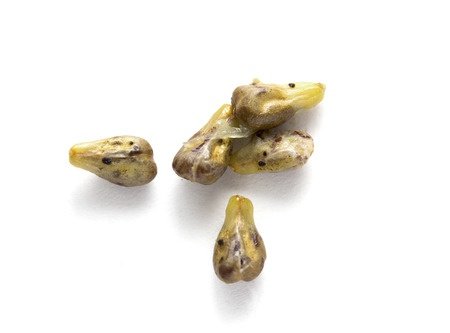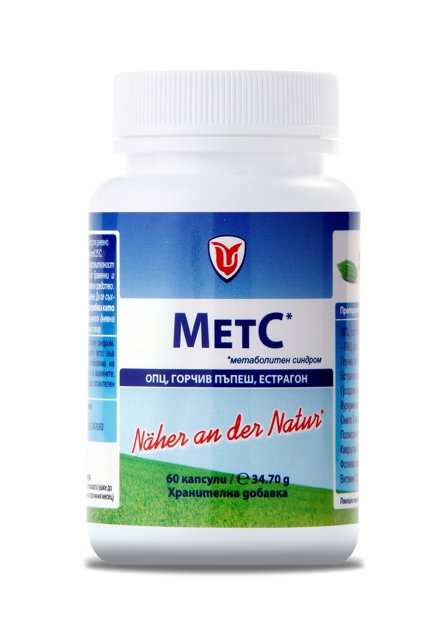The recommended daily dose contains:
- OPCs (oligomers of procyanidins) and PACs (proanthocyanidins) from grape seeds 150,000 mg
- Bitter melon (extract 10:1) 140,000 mg
- Tarragon (extract) 130,000 mg
- Grape seeds (extract) 90,000 mg
- Curcuminoids 50,000 mg
- Omega 3 fatty acids 40,000 mg
- Policosanol 95% 40,000 mg
- Quercetin 95% 20,000 mg
- Folic acid 0,400 mg
- Vitamin D (cholecalciferol) 0.006 mg
OPCs (oligomers of procyanidins) and PACs (proanthocyanidins) from grape seeds
OPC is an abbreviation for a group of substances, oligomers of procyanidins, which are found mainly in grape seeds. These bitter polyphenols are tasted when grape seeds are chewed. OPC is known to protect our cells as a strong and long-term effective antioxidant and to have an extremely positive effect on all symptoms of metabolic syndrome. OPCs develop their main antioxidant effect by neutralizing so-called free oxygen radicals. Free oxygen radicals are classified as harmful to our health in the long term because they attack and destroy cells or cell walls, enzymes, our DNA and more. This can lead to serious health problems. Free radicals are constantly in our body, but the body maintains a balance. Radicals appear mostly from environmental toxins, tobacco smoke, stress and exercise, but with obesity, chronic diseases or medication etc., more radicals can appear, leading to an imbalance, so the amount of free radicals in the body can increase. Free radicals are neutralized by antioxidants, which, however, are used up in the process, so they must be constantly supplied with food or with appropriate nutritional supplements. Grape seeds contain OPCs, PACs (proanthocyanidins), polyphenols, anthocyanins and catechins, which are also powerful natural antioxidants.
The PACs in grape seeds, in addition to being equally powerful antioxidants, improve insulin sensitivity and have a rejuvenating effect on cells. In this way, they protect against cardiovascular diseases, obesity and oncological problems.
|
Bitter melon (extract 10:1)
Bitter melon (Momordica Charantia) is an exotic fruit that is known as one of the best herbal remedies for diabetes. It contains quarantine, which lowers blood sugar levels and protects against complications arising from diabetes. Bitter melon regulates the secretion of insulin and limits the risk of cataracts or the development of pancreatic cancer. Weight gain and accumulation of fat around the abdomen are the first symptoms of obesity. Bitter melon helps with that too. Several studies have shown that it has a positive effect on controlling weight and preventing obesity. The extract of the green fruit is also considered an effective means for purifying the blood of toxins, for regulating high cholesterol and for treating viral diseases and inflammations of any nature. The plant stimulates digestion, tones and helps to treat constipation. It also strengthens the immune system. The ingredients in it may also be useful in fighting the AIDS virus. Bitter melon is used for a variety of other medicinal purposes – for colic, fever, malaria, burns, painful menstruation, skin problems, cough, rheumatism, liver diseases, smallpox, etc.
|
Tarragon (extract)
The aromatic herb Estragon (Tarragon) is known not only as a main spice in French cuisine, but also as a useful food supplement in alternative medicine. A powerful antioxidant, tarragon has a variety of beneficial effects on our body. Because it helps the liver work, tarragon is also known as a digestive aid, soothing an upset stomach and intestines and dyspepsia. Tarragon contains various substances that have a positive effect on the cardiovascular system, preventing the accumulation of plaques on the vessel walls. In addition, tarragon has a beneficial effect on eye health, female organs, stress tension, lack of appetite, toothache, etc.
|
Grape seeds (extract)
OPC or oligomer procyanidins are very powerful and are sometimes called natural super antioxidants. Their antioxidant action is determined by their extremely condensed aromatic rings, which are perfect stabilizers of free radicals. Polyphenols, anthocyanins and catechins enhance the OPC antioxidant effect and slow down aging processes. Even in the often bitter red grape seeds, high levels of OPCs, polyphenols and anthocyanidins have been found.
|
Curcuminoids
Turmeric (Curcuma Longa) has so many useful properties that it is currently at the top of the list of medicinal and most frequently mentioned plants.
One of the main benefits of turmeric is its anti-inflammatory effect. This, together with its analgesic effect, is successfully used in the treatment of arthritic diseases of all types and stages. Turmeric is a natural anti-inflammatory that can be taken for life without side effects.
Laboratory studies show that taking turmeric has a positive effect on cancer. The results showed a greater amount of destroyed cancer cells, a reduction in the size of tumors and blocking the formation of propagating enzymes when turmeric was included as a concomitant treatment.
The intake of turmeric also soothes allergic reactions of the body of any origin, as well as increases the body's resistance to the irritating factor.
Another beneficial property of turmeric is that it supports digestion and accelerates fat metabolism. It is also known that no other natural remedy has yet been found to have as strong an effect as turmeric for lowering blood sugar and lowering insulin resistance. Research over the past five years has shown that turmeric is literally 400 times more potent than conventional drugs in boosting insulin sensitivity. The effectiveness and results of taking turmeric have been compared to the results of conventional medications such as Lipitor, corticosteroids, Prozac, aspirin, oxaliplatin, metformin and other antidepressants, blood thinners, cholesterol-lowering and anti-inflammatory drugs.
In addition, it helps to prevent and delay the disease states formed as a result of diabetes. Another important positive effect of taking turmeric is reducing symptoms of depression. The results of a clinical study from 2013. show that in mild depression, turmeric can be used as a primary, effective and safe treatment instead of conventional drugs.
|
Omega 3 fatty acids
Omega 3 fatty acids are one of the most effective supplements for stimulating the immune system and preventing cardiovascular diseases. Derived from microencapsulated fish oil, omega 3 fatty acids are known to help lower triglycerides, normalize high blood pressure, increase good cholesterol levels, prevent plaque build-up in blood vessels, and have anti-inflammatory effects. With all this, they help with metabolic syndrome and protect against cardiovascular diseases.
Recent research has linked the use of omega 3 fatty acids to improved brain function, including mood in depression. It is recommended to take it in combination with Siberian ginseng (Eleutherococcus) against spring fatigue, as they mutually enhance their action.
|
Policosanol 95%
Sugarcane policosanol is a mixture of primary, aliphatic alcohols with the major component octosanol. Policosanol has recently shown cholesterol-lowering results and has been successfully tested in cerebral circulatory disorders (cerebral ischemia in a monkey model). In sports, isolated octacosanol is administered for better use of inhaled oxygen during sports activities. This application is supported by clinical studies in patients with heart disease, in which improvement in aerobic capacity and reduction in cardiovascular events such as ischemic attacks were observed.
Policosanol is derived from sugarcane wax and improves the composition of triglycerides in the blood. It lowers LDL cholesterol and raises HDL cholesterol.
|
Quercetin 95%
Quercetin is a powerful antioxidant flavonoid that neutralizes the harmful effects of free radicals and thus prevents malignant changes in cells. Quercetin is known to be anti-inflammatory and has a positive effect on atherosclerosis, high cholesterol, heart disease, circulatory problems, diabetes and insulin dependence, stomach ulcers, as well as being immune-boosting and positive allergies. It is also widely used in the treatment of prostate problems.
|
Folic acid
Vitamin B9 is much better known by the chemical name "folic acid". Like all vitamins of the group, folic acid supports the metabolism of substances and energy of the cells of the body. In addition, folic acid performs important functions in cell division and cell growth. The building of genetic material, red blood cells and muscles function smoothly with only folic acid. Anemia, skin changes and difficult wound healing can be manifestations of a lack of folic acid or vitamin B9. During pregnancy, consistent coverage of daily needs is generally recommended, as abnormalities in unborn babies are associated with a lack of folic acid. Folic acid can have a positive effect on blood vessels, and therefore there should be enough of it in case of cardiovascular diseases. Vegetables are a valuable supplier of folic acid. Especially spinach, cabbage, broccoli and tomatoes contain a lot of it. But also whole grains, eggs, wheat germ and soy products contribute to an adequate supply of folic acid. Depending on the particular food product, the absorption of folic acid in the intestine differs. Folic acid deficiency is more common than previously thought. Folic acid supplements can be a useful addition to food. Folic acid increases appetite, is effective against anemia and protects against birth defects, parasites in the digestive system and food poisoning. It provides a good texture to the skin and acts as an analgesic to relieve pain. It also improves the production of breast milk and counteracts the loss of hair color.
|
Vitamin D (cholecalciferol)
Cholecalciferol (or Calciol for short), vitamin D3 is the physiologically occurring vitamin D in all non-plant eukaryotes and, accordingly, in humans. In food, it is mainly found in fish or added to food as a food additive. In the body, it assumes the function of a precursor and through an intermediate stage is converted into calcitriol. Vitamin D plays an important role in regulating blood calcium levels and bone structure. Vitamin D deficiency leads in the medium term to childhood rickets, and in adults to osteomalacia/osteoporosis. Since the 1990s, vitamin D has been shown to have functions in a variety of other tissues that include cell differentiation, inhibition of cell proliferation, apoptosis (cell death), immune modulation, and control of other systems. Vitamin D deficiency, according to the results of previous studies, is a risk factor for autoimmune diseases, such as multiple sclerosis, Crohn's disease, diabetes mellitus type 1), infectious diseases, high blood pressure, cardiovascular diseases, metabolic syndrome, muscle weakness, dementia, Parkinson's disease and disorders of the effective functioning of the brain. Vitamin D is protective against various types of cancer, such as breast cancer, leukemia, kidney cancer, ovarian cancer, and pancreatic cancer. In addition, vitamin D may reduce the number of falls in people over 65. Taking 700-1000 IU reduces the risk of falling by 19%.
|




Ива Кирова –
Ендокриноложката ми го препоръча. С диабет съм и започнах да си чувствам много по-добре краката! Продължавам да го пия и се надявам да има още положителен ефект, че ми е писнало от страничните ефекти на лекарствата…